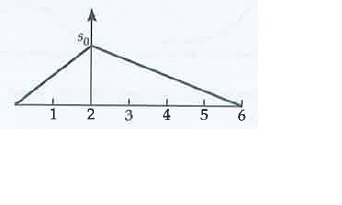A body starts from rest and is acted on by a constant force. The ratio of kinetic energy gained by it in the first five seconds to that gained in the next five seconds is
2:1
1:1
3:1
1:3
The correct Answer is:D
To solve the problem, we need to find the ratio of the kinetic energy gained by a body in the first five seconds to that gained in the next five seconds when acted upon by a constant force.
1. Understanding the Motion:
The body starts from rest and is acted upon by a constant force. This means the acceleration (a) is constant.
2. Kinematic Equations:
Since the body starts from rest, the initial velocity (u) is 0. The final velocity (v) at any time t can be given by the equation:
v=u+at=0+at=at
3. Kinetic Energy Calculation:
The kinetic energy (KE) of the body at any time t is given by:
KE=12mv2
Substituting for v, we have:
KE=12m(at)2=12ma2t2
4. Kinetic Energy from 0 to 5 seconds:
For the first 5 seconds (t = 5):
KE0 to 5=12ma2(5)2=12ma2⋅25=252ma2
5. Kinetic Energy from 0 to 10 seconds:
For the first 10 seconds (t = 10):
KE0 to 10=12ma2(10)2=12ma2⋅100=50ma2
6. Kinetic Energy from 5 to 10 seconds:
The kinetic energy gained from 5 to 10 seconds is the difference between the kinetic energy at 10 seconds and the kinetic energy at 5 seconds:
KE5 to 10=KE0 to 10−KE0 to 5=50ma2−252ma2
To perform the subtraction:
KE5 to 10=50ma2−12.5ma2=37.5ma2=752ma2
7. Finding the Ratio:
Now, we can find the ratio of the kinetic energy gained in the first 5 seconds to that gained in the next 5 seconds:
Ratio=KE0 to 5KE5 to 10=252ma2752ma2=2575=13
Final Answer:
The ratio of kinetic energy gained by the body in the first five seconds to that gained in the next five seconds is 13.
The body starts from rest and is acted upon by a constant force. This means the acceleration (a) is constant.
Since the body starts from rest, the initial velocity (u) is 0. The final velocity (v) at any time t can be given by the equation:
v=u+at=0+at=at
The kinetic energy (KE) of the body at any time t is given by:
KE=12mv2
Substituting for v, we have:
KE=12m(at)2=12ma2t2
For the first 5 seconds (t = 5):
KE0 to 5=12ma2(5)2=12ma2⋅25=252ma2
For the first 10 seconds (t = 10):
KE0 to 10=12ma2(10)2=12ma2⋅100=50ma2
The kinetic energy gained from 5 to 10 seconds is the difference between the kinetic energy at 10 seconds and the kinetic energy at 5 seconds:
KE5 to 10=KE0 to 10−KE0 to 5=50ma2−252ma2
To perform the subtraction:
KE5 to 10=50ma2−12.5ma2=37.5ma2=752ma2
Now, we can find the ratio of the kinetic energy gained in the first 5 seconds to that gained in the next 5 seconds:
Ratio=KE0 to 5KE5 to 10=252ma2752ma2=2575=13
The ratio of kinetic energy gained by the body in the first five seconds to that gained in the next five seconds is 13.
Topper's Solved these Questions
- WORK POWER AND ENERGYBook:NARAYNAChapter:WORK POWER AND ENERGYExercise:Level- II (C.W)
Explore 68 Videos
- WORK POWER AND ENERGYBook:NARAYNAChapter:WORK POWER AND ENERGYExercise:Level- III (C.W)
Explore 50 Videos
- WORK POWER AND ENERGYBook:NARAYNAChapter:WORK POWER AND ENERGYExercise:C.U.Q-Key
Explore 75 Videos
- WORK , ENERGY & POWER Book:NARAYNAChapter:WORK , ENERGY & POWER Exercise:EXERCISE IV
Explore 43 Videos
Similar Questions
What will be ratio of speed in first two seconds to the speed in next 4 seconds ?

View SolutionA body travels for 15 second starting from rest with constant acceleration. If it travels distances S1,S2andS3 in the first five seconds, second five seconds and next five seconds respectively the relation between S1,S2andS3is
View Solution
Knowledge Check
A body initially at rest is acted upon by a constant force. The rate of change of its kinetic energy varies
Alinearly with square root of timeBlinearly with timeClinearly with square of timeDinversely with timeA body starts from rest and moves with constant acceleration. The ratio of distance covered by the body in nth second to that covered in n second is.
A1nB2n−1n2Cn22n−1D2n−12n2A body starting from rest moves with constant acceleration. The ratio of distance covered by the body during the 5th second to that covered in 5 seconds is
A125B325C925D125
A body starting from rest moves with constant acceleration. What is the ratio of distance covered by the body during the fifth second of time to that covered in the first 5.00 s ?
View SolutionA particle starts from rest and moves along a straight line with uniform acceleration. The ratio of distance travelled by the particle during the first three seconds to the distance travelled by the particle during the next three seconds is 3 о 2
View SolutionA particle starts from rest and moves along a straight line with uniform acceleration. The ratio of distance travelled by the particle during the first three seconds to the distance travelled by the particle during the next three seconds is 3 о 2
View SolutionA body starts from rest and moves with uniform acceleration. What is the ratio of kinetic energies at the end of 1st,2nd and 3rd seconds of its journey ?
View SolutionA particle start moving from rest state along a straight line under the action of a constant force and travel distance x in first 5 seconds. The distance travelled by it in next five seconds will be
View Solution

